| "The Road to Oregon: A Chronicle of the Great Emigrant Trail" by W. J. Ghent, pub. 1929 Excerpts from Chapter 1, The Pathmakers |
Wild animals made the first trails. The buffalo moved in such great masses that on
open ground he was a destroyer, rather than a maker, of trails; but the deer, the elk,
and the antelope left pathways over the plains and along the valleys and among the
foothills, and the loftiest heights showed the track of the bighorn sheep. The Indian
followed, and he also made paths of his own, peace trails to the villages of his friends,
war trails to the country of his enemies, hunting trails that intercepted the herds on
their migrations or struck them in their winter retreats. Wild animal and Indian alike
chose the easiest way, the route with the fewest obstacles.
When the fur-trappers invaded the West they found a criss-cross pattern of many
trails. Some of these for a time they followed, but oftener they made their way
through an untracked wilderness. They were hunting for beaver, and far and wide they
searched wherever beaver might be found. Perhaps none of them ever trod the floor of
the Grand Canyon of the Colorado, but elsewhere they seem to have penetrated to
every niche and cranny of the rugged West. Long before the Government undertook any
general exploration of this vast region, virtually all of it had become known, in minute
detail, to the hardy and indomitable trappers.
This early exploration was largely financed by the plug hat of our forefathers. The
dauntless spirits who in the face of every peril kept to their quest could hardly have
indulged their passion for adventure but for the good money commanded by the beaver
pelt. Fashion decreed the high hat of prime beaver fur, and even the unfashionable
accepted the decree. Assuredly the beaver fur had many other uses; the Chinese, for
instance, who were never addicted to high hats, were its eager buyers; but its steady
demand as material for headgear gave stability to the trade. In 1832 came the silk
hat, with the result that by another seven years the price of beaver fur in London fell
to one-eighth of its former level. For a time American fashion resisted the innovation.
As late as 1846 Oliver Wendell Holmes could write the impressive counsel to men who
wished to dress both modishly and well: Have a good hat; the secret of your looks lives
with the beaver in Canadian brooks..... some years after the silk hat had won a certain
favor in Europe and the beaver had virtually disappeared from the brooks of Wyoming
and Montana. The drop in the price of fur, along with the gradual exhaustion of the
supply, had paralyzed the trapping industry and driven the trappers from the mountains.
These trapper-explorers, or "mountain men," who broke the trails that opened up the
West, were a unique breed of men. They had no forerunners, and their like can never
again appear on the earth. Irving's familiar tribute, based on the word of Bonneville,
tells what toils they endured and what perils they faced:
There is, perhaps, no class of men on the face of the earth, who lead a life of more
continued exertion, peril and excitement, and who are more enamoured of their
occupations, than the free trappers of the West. No toil, no danger, no privation can
turn the trapper from his pursuit. His passionate excitement at times resembles a
mania. In vain may the most vigilant and cruel savages beset his path; in vain may
rocks, and precipices, and wintry torrents oppose his progress; but let a single track of
beaver meet his eye, and he forgets all dangers and defies all difficulties. At times he
may be seen with his traps on his shoulder, buffeting his way across rapid streams,
amidst floating blocks of ice: at other times, he is to be found with his traps swung on
his back clambering the most rugged mountains, scaling or descending the most frightful
precipices, searching, by routes inaccessible to the horse, and never before trodden by
white man, for springs and lakes unknown to his comrades, and where he may meet with
his favorite game. Such is the mountaineer, the hardy trapper of the West.
From the journal of Osborne Russell, himself a trapper, April, 1838:
Early next morning about thirty of us were armed, equipped and mounted, as
circumstances required. A trapper's equipment in such cases is generally one animal upon
which is placed one or two epishemores [apishamores, saddle blankets], a riding saddle
and bridle, a sack containing six beaver traps, a blanket with an extra pair of
moccasins, his powder horn and bullet pouch, with a belt to which is attached a butcher
knife, a wooden box containing bait for beaver, a tobacco sack with a pipe and
implements for making fire, with sometimes a hatchet fastened to the pommel of his
saddle. His personal dress is a flannel or cotton shirt (if he is fortunate enough to
obtain one, if not antelope skin answers the purpose of over and undershirt), a pair of
leather breeches with blanket or smoked buffalo skin leggings, a coat made of blanket
or buffalo robe, a hat or cap of wool, buffalo or other skin, his hose are pieces of
blanket wrapped around his feet, which are covered with a pair of moccasins made of
dressed deer, elk or buffalo skins, with his long hair falling loosely over his shoulders,
completes his uniform. He then mounts and places his rifle before him on his saddle.
Such was the dress equipage of the party, myself included, now ready to start.
This time has been called the romantic period of the frontier, and again, more
appropriately, the heroic period. Many of the icy streams the trappers waded were
rich in the precious metal, though the fact did not become known until years after they
had scattered to other scenes.
open ground he was a destroyer, rather than a maker, of trails; but the deer, the elk,
and the antelope left pathways over the plains and along the valleys and among the
foothills, and the loftiest heights showed the track of the bighorn sheep. The Indian
followed, and he also made paths of his own, peace trails to the villages of his friends,
war trails to the country of his enemies, hunting trails that intercepted the herds on
their migrations or struck them in their winter retreats. Wild animal and Indian alike
chose the easiest way, the route with the fewest obstacles.
When the fur-trappers invaded the West they found a criss-cross pattern of many
trails. Some of these for a time they followed, but oftener they made their way
through an untracked wilderness. They were hunting for beaver, and far and wide they
searched wherever beaver might be found. Perhaps none of them ever trod the floor of
the Grand Canyon of the Colorado, but elsewhere they seem to have penetrated to
every niche and cranny of the rugged West. Long before the Government undertook any
general exploration of this vast region, virtually all of it had become known, in minute
detail, to the hardy and indomitable trappers.
This early exploration was largely financed by the plug hat of our forefathers. The
dauntless spirits who in the face of every peril kept to their quest could hardly have
indulged their passion for adventure but for the good money commanded by the beaver
pelt. Fashion decreed the high hat of prime beaver fur, and even the unfashionable
accepted the decree. Assuredly the beaver fur had many other uses; the Chinese, for
instance, who were never addicted to high hats, were its eager buyers; but its steady
demand as material for headgear gave stability to the trade. In 1832 came the silk
hat, with the result that by another seven years the price of beaver fur in London fell
to one-eighth of its former level. For a time American fashion resisted the innovation.
As late as 1846 Oliver Wendell Holmes could write the impressive counsel to men who
wished to dress both modishly and well: Have a good hat; the secret of your looks lives
with the beaver in Canadian brooks..... some years after the silk hat had won a certain
favor in Europe and the beaver had virtually disappeared from the brooks of Wyoming
and Montana. The drop in the price of fur, along with the gradual exhaustion of the
supply, had paralyzed the trapping industry and driven the trappers from the mountains.
These trapper-explorers, or "mountain men," who broke the trails that opened up the
West, were a unique breed of men. They had no forerunners, and their like can never
again appear on the earth. Irving's familiar tribute, based on the word of Bonneville,
tells what toils they endured and what perils they faced:
There is, perhaps, no class of men on the face of the earth, who lead a life of more
continued exertion, peril and excitement, and who are more enamoured of their
occupations, than the free trappers of the West. No toil, no danger, no privation can
turn the trapper from his pursuit. His passionate excitement at times resembles a
mania. In vain may the most vigilant and cruel savages beset his path; in vain may
rocks, and precipices, and wintry torrents oppose his progress; but let a single track of
beaver meet his eye, and he forgets all dangers and defies all difficulties. At times he
may be seen with his traps on his shoulder, buffeting his way across rapid streams,
amidst floating blocks of ice: at other times, he is to be found with his traps swung on
his back clambering the most rugged mountains, scaling or descending the most frightful
precipices, searching, by routes inaccessible to the horse, and never before trodden by
white man, for springs and lakes unknown to his comrades, and where he may meet with
his favorite game. Such is the mountaineer, the hardy trapper of the West.
From the journal of Osborne Russell, himself a trapper, April, 1838:
Early next morning about thirty of us were armed, equipped and mounted, as
circumstances required. A trapper's equipment in such cases is generally one animal upon
which is placed one or two epishemores [apishamores, saddle blankets], a riding saddle
and bridle, a sack containing six beaver traps, a blanket with an extra pair of
moccasins, his powder horn and bullet pouch, with a belt to which is attached a butcher
knife, a wooden box containing bait for beaver, a tobacco sack with a pipe and
implements for making fire, with sometimes a hatchet fastened to the pommel of his
saddle. His personal dress is a flannel or cotton shirt (if he is fortunate enough to
obtain one, if not antelope skin answers the purpose of over and undershirt), a pair of
leather breeches with blanket or smoked buffalo skin leggings, a coat made of blanket
or buffalo robe, a hat or cap of wool, buffalo or other skin, his hose are pieces of
blanket wrapped around his feet, which are covered with a pair of moccasins made of
dressed deer, elk or buffalo skins, with his long hair falling loosely over his shoulders,
completes his uniform. He then mounts and places his rifle before him on his saddle.
Such was the dress equipage of the party, myself included, now ready to start.
This time has been called the romantic period of the frontier, and again, more
appropriately, the heroic period. Many of the icy streams the trappers waded were
rich in the precious metal, though the fact did not become known until years after they
had scattered to other scenes.
The trails that later became useful to the emigrants were the paths along which the
trappers carried their furs to the frontier capital, St. Louis, or made their way
between the Columbia and the Green. The Valley of the Green River was the strategic
center of all the activities of the trappers; and the low gap by which it was entered
from the east, South Pass, became the chief gateway to the Pacific and so remained
until the building of the railroad. Out of the most practicable of these various
travel-stretches, linked end to end, slowly evolved the Oregon Trail. Its course was
dictated by the contour of the country, the drainage, herbage, and forestation. This
route to the Pacific in time bore many names. To some it was the Platte Trail, to
others, the Emigrant Road or the Road to Oregon. In later years, it became known as
the Overland Trail. With varying and usually inappropriate meanings the names of the
Mormon Trail and the Great Salt Lake Trail were also applied to it. To the Indians
generally, according to Father de Smet, it was the Great Medicine Road of the Whites,
while to Washakie's band of Eastern Shoshones it was the White-Topped Wagon Road.
The first party of whites known to have journeyed along any section of what was to
become the Oregon Trail was that of Wilson Price Hunt's overland Astorians in
1811-12, and the section was in the remote West. The Lewis and Clark expedition of
1804-06 traveled no part of the Trail. In the spring of 1811, Hunt started out, with
sixty men, one woman (the Indian wife of the interpreter, Dorion), and two children, on
his memorable journey through the western wilderness. John Jacob Astor had
determined upon his magnificent venture of setting up an establishment oat the mouth of
the Columbia; to this projected Astoria he had sent one expedition by sea, and he had
chosen hunt to lead another by land. About the middle of July, Hunt's party traveled
through what is now Wyoming to where the Wind River turns north and becomes the
Bighorn, ascended the Wind, crossed the two ranges westward and reached the
abandoned fort which Major Andrew Henry had established on Henry's Fork of the
Snake the previous fall. The remote western section was further followed or paralleled
by the two Snake expeditions of the North West Company in 1818-20 and by the four
expeditions of the Hudson's Bay Company in 1824-29.
The most important of the early expeditions following the discover of South Pass was
that of Smith, Jackson and Sublette. It marked the beginning of wheel traffic on the
Oregon Trail. The train was composed of ten loaded wagons, drawn by five mules each
and two Dearborn carriages, drawn by one mule each, left St. Louis on April 10, 1830..
It was led by Sublette, for his partners were then in the mountains. It followed the
Santa Fe Trail about forty miles then went some degrees north of west, crossing the
Kansas and reaching Platte, which it followed to the Rocky Mountains and to the head of
Wind River where it issues from the mountains. It left the Trail near the present
Casper, Wyoming. It arrived on July 16 and the partners sold their company to the
Rocky Mountain Fur Company. Three weeks later, the train started on its return and
reached St. Louis on October 10.
trappers carried their furs to the frontier capital, St. Louis, or made their way
between the Columbia and the Green. The Valley of the Green River was the strategic
center of all the activities of the trappers; and the low gap by which it was entered
from the east, South Pass, became the chief gateway to the Pacific and so remained
until the building of the railroad. Out of the most practicable of these various
travel-stretches, linked end to end, slowly evolved the Oregon Trail. Its course was
dictated by the contour of the country, the drainage, herbage, and forestation. This
route to the Pacific in time bore many names. To some it was the Platte Trail, to
others, the Emigrant Road or the Road to Oregon. In later years, it became known as
the Overland Trail. With varying and usually inappropriate meanings the names of the
Mormon Trail and the Great Salt Lake Trail were also applied to it. To the Indians
generally, according to Father de Smet, it was the Great Medicine Road of the Whites,
while to Washakie's band of Eastern Shoshones it was the White-Topped Wagon Road.
The first party of whites known to have journeyed along any section of what was to
become the Oregon Trail was that of Wilson Price Hunt's overland Astorians in
1811-12, and the section was in the remote West. The Lewis and Clark expedition of
1804-06 traveled no part of the Trail. In the spring of 1811, Hunt started out, with
sixty men, one woman (the Indian wife of the interpreter, Dorion), and two children, on
his memorable journey through the western wilderness. John Jacob Astor had
determined upon his magnificent venture of setting up an establishment oat the mouth of
the Columbia; to this projected Astoria he had sent one expedition by sea, and he had
chosen hunt to lead another by land. About the middle of July, Hunt's party traveled
through what is now Wyoming to where the Wind River turns north and becomes the
Bighorn, ascended the Wind, crossed the two ranges westward and reached the
abandoned fort which Major Andrew Henry had established on Henry's Fork of the
Snake the previous fall. The remote western section was further followed or paralleled
by the two Snake expeditions of the North West Company in 1818-20 and by the four
expeditions of the Hudson's Bay Company in 1824-29.
The most important of the early expeditions following the discover of South Pass was
that of Smith, Jackson and Sublette. It marked the beginning of wheel traffic on the
Oregon Trail. The train was composed of ten loaded wagons, drawn by five mules each
and two Dearborn carriages, drawn by one mule each, left St. Louis on April 10, 1830..
It was led by Sublette, for his partners were then in the mountains. It followed the
Santa Fe Trail about forty miles then went some degrees north of west, crossing the
Kansas and reaching Platte, which it followed to the Rocky Mountains and to the head of
Wind River where it issues from the mountains. It left the Trail near the present
Casper, Wyoming. It arrived on July 16 and the partners sold their company to the
Rocky Mountain Fur Company. Three weeks later, the train started on its return and
reached St. Louis on October 10.
By 1832, Independence, Missouri had taken the lead as the jumping-off place for all
westward expeditions. Occasionally, in these early years, as steamboat transit
developed, an expedition would be transported as far as the new trading post of
Bellevue, at the mouth of the Platte. But, by far, in these years, more expeditions
started out from Independence than anyplace else.
The route from Independence to the mouth of the Walla Walla was the original Oregon
Trail, parent of all the central routes to the Pacific. This great highway ran through a
wilderness. From Independence to Fort Walla Walla there was nowhere along its line,
at the beginning of 1832, even a cabin. Shaped gradually by the trappers, this road
was now to be traveled by the missionaries, and in a few years by thousands of
emigrants seeking homes on the Pacific.
westward expeditions. Occasionally, in these early years, as steamboat transit
developed, an expedition would be transported as far as the new trading post of
Bellevue, at the mouth of the Platte. But, by far, in these years, more expeditions
started out from Independence than anyplace else.
The route from Independence to the mouth of the Walla Walla was the original Oregon
Trail, parent of all the central routes to the Pacific. This great highway ran through a
wilderness. From Independence to Fort Walla Walla there was nowhere along its line,
at the beginning of 1832, even a cabin. Shaped gradually by the trappers, this road
was now to be traveled by the missionaries, and in a few years by thousands of
emigrants seeking homes on the Pacific.
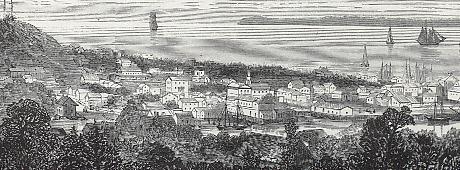
| St. Louis, Missouri The Illustrated London News, 1858 |
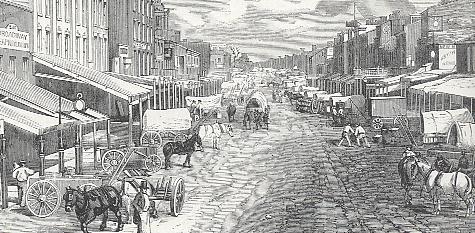
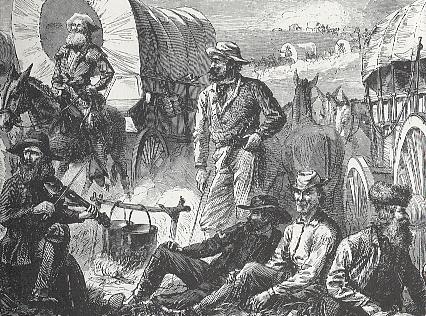
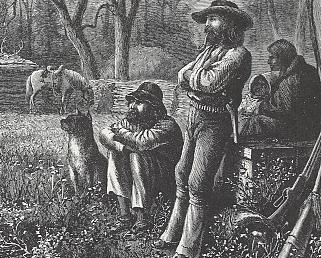
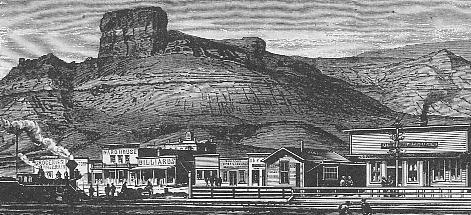
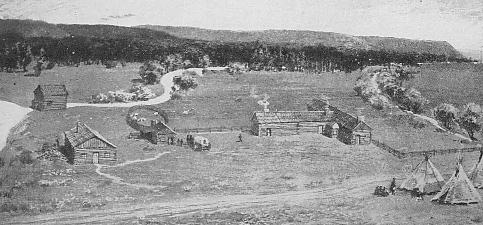
| Green River Station, Wyoming Territory Frank Leslie's Illustrated Newspaper, 1877 |
| John Jacob Astor's settlement, Astoria, Oregon; founded in 1811 Harpers Weekly, 1868 |
| Whitman's Mission at Waiilatpu, 1843 From Myron Eells' "Marcus Whitman, Pathfinder and Patriot" |
| Guides and wagon drivers relax after a day on the trail Harpers Weekly, 1871 |
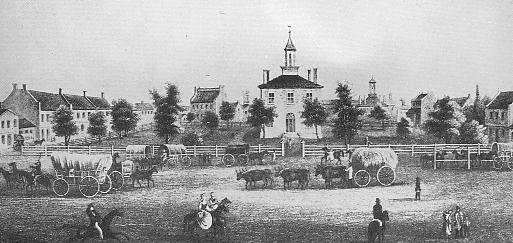
| Independence, Missouri --- the starting point for most western pioneers |
| Settlers on the Missouri River in Northern Montana Territory Harper's Weekly, 1875 |
